
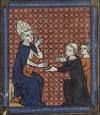





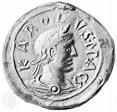








TLW's Parisscope™ (Paris Historyscope) |
By T.L. Winslow (TLW), the Historyscoper™ |
© Copyright by T.L. Winslow. All Rights Reserved. |
Original Pub. Date: June 16, 2017. Last Update: Mar. 27, 2020. |







Westerners are not only known as history ignoramuses, but double dumbass history ignoramuses when it comes to Paris history. Since I'm the one-and-only Historyscoper (tm), let me quickly bring you up to speed before you dive into my Master Historyscope.
About 250 B.C.E. Paris in Gaul is founded as Lutetia by the Celtic Parisii in the Ile de la Cite (Île de la Cité), the island in the middle of the Seine River, with the Pont Neuf ("new bridge") spanning the Seine River at the downstream (W) point.
About 58 B.C.E. Julius Caesar coins the term "Germanic" for the tribes living N of the Rhine, and "Celtic" for the tribes living S of the Rhine; Gallia Transalpina (Galla Ulterior) (which looks like a giant smorgasboard to the Romans) is split between three main nations, the tall, fair, gregarious Celtic Belgae (Belgi) (Gael. "sacred tree") tribe in the N (to the Rhine), the rest of the Celts in the middle, and the dark-complected Tarbelli in the SW (Aquitaine), who prefer to fight in small bands; "Physically the Celts are terrifying in appearance with deep-sounding and very harsh voices. In conversation they use few words and speak in riddles, for the most part hinting at things and leaving a great deal to be understood. They frequently exaggerate with the aim of extolling themselves and diminishing the status of others. They are boasters and threateners, and given to bombastic self-dramatization, and yet they are quick of mind and with good natural ability for learning" (Diodorus Siculus, Book 5); the major Celtic tribes in Belgian Gaul (Gallia Belgica) in NE Gaul are the seafaring Menapii in N Gaul in the mouth of the Rhine River S along the Scheldt River, with main city of Cassel near Tarwanna, the Nervii (of Germanic origin?) S of them (E of the Scheldt River), the Morini (Gael. "people of the Sea") on the NW coast based in Boulogne-sur-Mer and Tarwanna (Tervanna) (modern-day Therouanne), and the Caleti (Caletes) on the coast of modern-day Normandy, the Remi in NE Gaul between the Mosa (Meuse) and the Matrona (Marne) (incl. the town of Durocorter or Reims), the Suessiones (Suessones) in W Gallia Belgica between the Oise and Marne Rivers centered around Soissons, the Meldi ("honey people") on the Marne River (near modern-day Meaux), the Catuvellauni N of the Sequana (Seine) River, the Treveri (Treviri) in the lower Moselle River Valley, the Mediomatrici S of the Treveri W of the Vosges River, with capital at Divodurum (modern-day Metz), the Lingones at the headwaters of the Seine and Marne Rivers, with capital at Andematunnum ("fortress of the great bear") on the Marne River near modern-day Langres, the coastal 5-tribe confederation of Armorica (Aremorica) (Celt. "near the sea") between the Seine and Loire Rivers, incl. the Osismii ("deer people") in Finis Terrae (Lat. "ends of the Earth") in Brittany with capital at Vorgium (modern-day Carhaix) (known for trading with Ireland and Britain), the Redones (Rhedones) on the Liger (Loire) River, with capital at Condate (modern-day Rennes), the Veneti in the Brittany Peninsula, the Venelli (Veneli) (Unelli) in the Cherbourg Peninsula, the Sequani in the Arar (Saone) Rivver Valley of the Doubs in the Jura Mts. (modern-day Franche-Comte) (known for their smoked ham), the Helvetii in W Switzerland (composed of the Verbigeni, Tigurini, Toygenoi, and one other subgroup), the Carnutes and Senones N of the Liger (Loire) River (modern-day Chartres, Orleans and Blois) (political and reigious center of Gaul), the Pictones (Pictavi) along the Bay of Biscay in W Gaul (most civilized and independent Celtic tribe?), the Bituriges ("rulers of the world", "perpetual kings") S of the Liger (Loire) River, with capital at Burdigala (Bordeaux) on the Garunna (Garonne) River, the Decetiae on island in the Loire River at the confluence with the Aron River in modern-day Decize; Aedui (Haedui) (Hedui) between the Liger (Loire) and Arar (Saone) Rivers (modern-day Burgundy) (known for being friendly with the Romans), the Santones (Santoni) (Santii) in modern-day Saintonge around the town of Saintes, the Arverni in Auvergne around the town of Gergovia (modern-day Clermont-Ferrand), the Ruteni ("blondes") in Aveyron (known as producers of lead), the Lemovices (Lemovici) in modern-day Limousin and Poitou, the Volcae and Tectosages (Tectosagii) in S Gaul, the Vulgientes (Vordenses) in SE Gaul, with capital at Apt, which Caesar changes to Apta Julia and beautifies; the Allobroges inhabit the Rhone Valley, incl. the key town of Lugdunum (modern-day Lyons) at the estuary of the Rhine River at the confluence of the Rhodanus (Rhone), Saone and Liger (Loire) Rivers, along with Cularo (modern-day Grenoble) on the Isere River 75 mi. SE of Lugdunum; the Vocantii (whose patron goddess is Andarta, goddess of fertility) inhabit the Rhone Valley and Alps to the S of the Allobroges; Gallia Cisalpina (Galla Citerior) (Po River Valley) is inhabited by the Celtic Boii, along with the Cenomani (Aulerci Cenomani) and Insubres (Insubria) of Insubria (modern-day Lombardy) (founders of Mediolanum or Milan); Gallia Provincia (Provence) (Province), the SE neck around the Mediterranean coast between the Alps and Pyrenees features the towns of Tolosa (Toulouse), Carcaso, Narbo (Narbonne), Massila (Marseille), Arelate (Arelas) (Arles), and Valentia; Flanders (Vaanderen), the region around the city of Bruges is inhabited by Celts; the Parisii inhabit Paris and the Seine Valley; Carnac on the Gulf of Morbihan in S Brittany 20 mi. SE of Lorient has the Carnac Stones, 1,991 granite menhirs arranged in 11 parallel rows, with a curved row of 18 stones at one end; about 1.5 mi. from Carnac Le Bosseno (a group of mounds) contains the remains of Caesar's Camp. In the spring Julius Caesar the Celt-Killer, proconsul in Gaul, using Narbonensis in the S as a base begins a series of annual campaigns in Gaul, first conquering the Suebi and killing their chieftain Ariovistus after all 370K of them begin a mass migration from W Switzerland to S Gaul under German pressure, right into Caesar's lap, and after killing 120K he orders the rest to return to their homeland and submit to Roman rule; he then strikes deeper into Gaul, and they come out swinging naked with short stabbing swords and fight for their free-ee-ee-dom, almost destroying his armies, but he holds on and kicks their butts with superior military org. and discipline in eight campaigns of the Gallic Rapes, er, Gallic Wars (end -50), making use of the fact that they have a 2-front war going on with the Germans across the Rhine River to divide and conquer, systematically exterminating them and setting Gaul up for Roman colonization while stealing their wealth to make himself rich; he eventually kills 1M of 10M, and enslaves another 1M; Caesar conquers Vesontio (modern-day Besancon) on the Doubs River (47 mi. E of modern-day Dijon), the principal town of the Sequani; meanwhile after a 3-year planning period, 260K Helvetii (mainly women and children?), led by Orgetorix strike out toward Gaul with the intention of (conquering it?) and settling among the Santoni between Poitiers and Bordeaux, using scorched earth tactics and gaining recruits as they go, reaching 200K-365K total (incl. 16K-40K warriors), reaching Geneva, only to find that Caesar and his 30K-man army have beat them to it and dismantled the bridge, after which they bypass him by going N over the Jura Mts. and ravaging the lands of the Aedui, who call on Caesar for aid, then crossing the Saone River; too bad, Caesar ambushes the last quarter of their forces on the E bank, incl. the Tigurini, and after negotiations fall through, the Helvetii defeat Caesar and continue their journey, while the rest of Caesar's army is stalled waiting for grain shipments, which are held up by the Aedui because its chieftain Dumnorix is the hubby of Orgetorix' daughter; after Caesar catches back up with them, he defeats them at the Battle of Bibracte (one of the 12 biggest towns in decentralized Gaul, which has no king and no capital city, and revolts civilized Romans with tales of the equality of women?), slaughtering and enslaving 250K and capturing most of their baggage as they flee to the lands of the Lingones on the Langres Plateau; after waiting three days to soften them up (or to lick his wounds), and ordering the Lingones not to help them, Caesar accepts their surrender and allows the remaining 110K to return home on the condition (foedus) that they supply fighting men on request; too bad, they lose their foederati status when they support Vercingetorix in -52; the Gauls are later discovered to be running 400+ gold mines (Caesar's real reason for invading?), and Caesar wastes no time glutting the Roman market with 70 tons of gold, causing prices to drop 25% as the Romans begin minting gold coins for the first time since ?; Caesar got his clue from the fact that despite an ideal climate, the Gauls imported their wine from Rome, revealing their wealth?

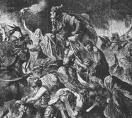
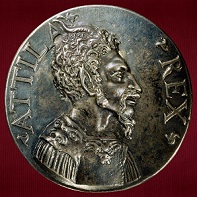




In 451 C.E. after Italy suffers a devastating famine this year and next, later helping convince him not to take the city of Rome, Attila the Hun (406-53) declares war on the Western Roman Empire, and, using the supposed marriage proposal of Valentinian III's sister (Galla Placidia's daughter) Justa Grata Honoria as an excuse crosses from Pannonia, destroying Emona (Lyublana), and arriving in Belgica with up to 500K troops from Germany and Scythia (incl. the Ostrogoths, who end up falling by the thousands to their kinsmen the Visigoths at Chalons), joined by the Franks (led by the elder rival for the throne) when he reaches the confluence of the Rhine and the Neckar Rivers, using trees from the Hercynian Forest to build a bridge to ford the Rhine in the spring, then sacking the towns of France, incl. Metz (Divodurum) (Apr. 7), Tongres, Cambrai, Rheims (Reims), Mainz, Strasbourg, Cologne, Trier, and Arles (Artebatum), mysteriously bypassing Paris after a short siege, then in June seriously sieging Aurelianum (Orleans) (100 mi. SSW of Paris on the Loire, originally the Roman settlement of Cenabum), which is saved by the efforts of Bishop Anianus (Aignan) (Agnan) (358-453), until Frankish-Burgundian-Celtic reinforcements under Roman Gen. Flavius Aetius and Visigoth King Theodoric I (with his sons Torismond and Theodoric II) arrive, causing Attila to retreat back past the Seine River to the plains of Chalons (E of Paris, between Reims on the N and Troyes on the S)), where his Scythian cavalry can operate advantageously on its smooth level surface; along the way to Orleans he and his hordes are allegedly miraculously diverted by the prayers of worthy Christian saints from various lucky towns, incl. Troyes (100 mi. SE of Paris) by St. Lupus (Loup) (383-479) (who gives himself as hostage to Attila), and don't forget Paris, allegedly saved by living saint (a Romanized Celt from Gaul) St. Genevieve (422-512) (Gael. "Gwenfrewi" = white wave or stream), AKA the Shepherd Girl of Nanterre (422-512); too bad that prayers to St. Servatius (-384) can't save Tongres (because God had already called him home?), nor can prayers to St. Ursula (-383) save Cologne, and poor Metz has no saints, so that Attila finds it no problemo, and massacres its priests, along with the infants that had just been baptised by the bishop, then burns it down, except for the Chapel of St. Stephen; meanwhile gen. Aetius and Theodoric I, having raised the support of the Romans, Visigoths and Franks, incl. the independent tribes of the Laeti (from Gaul), Armorici (between the Seine and Loire), Breones (Rhaetians from E of Lake Constance), Saxons (from the diocese of Bayreux), Burgundians (from Savoy), Sarmatians (Alani), Ripuarians (Ripuarii) (Ripari) (named from their posts on the rivers Rhine, Meuse and Moselle), and Franks (under Merowig), finally kick the butts of Attila's Hun hordes in June at the original Million-Man March, the 1M-man Battle of Chalons AKA the Battle of Catalaunian Fields (Plains) (Campus Mauriacus) near Troyes (in NE France) in the province of Campania (Champagne) (capital Rheims) (a good place to campaign your horses because it's so level?); previously during his retreat from Orleans the Gepids (Sluggards) under Attila's main man Ardaric (Arcadius) (aldigar) (-450) are mauled by the Franks, losing 15K men; the battle begins with a struggle for the heights, which is won by the Visigoths led by Theodoric I's eldest son Torismond (Thorismund) (-453), causing Attila to give a speech to his troops to whip them up, saying, "I myself will throw the first javelin, and the wretch who refuses to imitate the example of his soveriegn is devoted to inevitable death"; Attila ocupying the center of the battle line in person, the Gepids form the right wing, and the Ostrogoths form the left wing to oppose the Visigoths; on the other side Gen. Aetius and his Romans form the left wing, Theodoric I the right wing, and the Alani (settled in Aurelianum around Orleans) under Sangiban the meat-grinder center (to make him pay for promising Attila to open the city gates of Orleans for him?); Theodoric I is felled from his horse by a javelin thrown by the Ostrogoth Andages, then trampled to death by his own cavalry; the Alani flee or defect, but the Huns lose, and only the coming of night saves Attila from being captured, causing him to circle the wagons and order the saddles of his cavalry piled up to be used as his funeral pyre in case the camp should be taken?; 162K-300K men die on both sides in "a conflict fierce, various, obstinate, and bloody, such as could not be paralleled either in the present or in past ages" (Cassiodorus Senator); Europe is saved from having a Mongolian overlord, but Attila's example encourages many other barbarian tribes to swarm the sagging Roman Empire, worst of all being the seafaring vandalizing Vandals?; Torismond becomes king of the Visigoths (until 453), and after "crafty Aetius.. fearing that Rome might find a second Alaric... persuaded the young king to return at once to his capital" (Gibbon) withdraws his Visigoths back to Toulouse to prevent his brothers from usurping his throne, then Aetius withdraws, leaving Attila and his Huns alone on the plains of Chalons for several days licking their wounds (and facing plague?) until they decide to retreat NE back over the Rhine S of Cologne to count their loot, with the Franks under Merowig following them all the way to Thuringia in C Germany, learning of atrocities against hostages and maidens which the son of Clovis I revenges 80 years later; "[Attila's] retreat across the Rhine confessed the last victory which was achieved in the name of the Western Roman Empire" (Gibbon); Attila is not finished, however, and during the winter he plans some more fun in the Italian sun? - see ya later, alligator?

In 501 Merovingian king of the Salian Franks (since 481) Clovis I (466-511) moves his capital from Soissons to Paris after founding the Church of the Holy Apostles (St. Genevieve) there; Paris goes on to become the true capital of Europe, supplanting Rome; ironically the Gallic clergy are recruited almost totally from the Gallo-Roman pop.; "The converted Franks knelt at the feet of those whom they had conquered, and gave back in pious donations what they had stolen in war" (Will Durant, The Age of Faith, Ch. 21).
On Oct. 8, 614 (614?) Lothair II promulgates the Edict of Paris, a Frankish Magna Charta that reserves many rights to the Frankish nobles while excluding Jews from all civil employment for the crown and putting all literacy in the kingdom under ecclesiastical control, pleasing the nobles, from whose ranks the bishops are usually drawn.

In 845 the Danish Vikings stage a simultaneous attack on all three Frankish Carolingian kingdoms: Danish king Ragnar Lodbrok (Norse "hairy breeches") (-856) leads a fleet up the Seine River and sieges Paris; other Vikings invade Aquitaine and ravage as far as Limoges; other Vikings destroy Hamburg and begin a gen. attack on the Carolingian lands in Germany.
In 885 hundreds of Viking ships row up the Seine with 40K men and siege Paris for more than a year, defended by Count Odo (Eudes) of Paris; "The town trembles, and horns resound; the walls are bathed in floods of tears; the whole region laments; from the river are heard the horn blasts." Alfred the Great retaliates against the East Anglian Danes for helping the Danish invaders of the previous year, captures London and forces Guthram to sign a treaty relinquishing territory; the new boundary of Danelaw (known for its Five Burghs or fortified towns) runs from NW of London to Bedford, then along the old Roman road of Watling St. NW through Bedford and S of Leicester to Chester; Alfred now controls the SW half of the island, all nicely united under common fear of them *!?!* pesky Danes.


In spring 911 Norse Viking chief Rollo (Hrolf) (Rolf) Ragnvaldsson (the Ganger) (the Walker) (Wend-a-Foot) (845-930) (who once explored the E coast of North Am. as far S as Conn.?) sails down the Seine River with a raiding and settling party, and sieges Chartres, then prepares to ransack gay Paris, until whimpy king of the West Franks (Charles III, you are no Charlemagne?) Charles III the Simple (879-929) (probably hearing that the Vikings can be bought off, like Eli Wallach in the film "The Magnificent Seven", and saying something like, "Rollo, please do not sack gay Paree, just take this box of treasure, and I'll make you a duke and give you my beautiful daughter, the hottest French poontang in the land, and you can move into the bad side of France and have the left bank of the Seine, plus a little of the right bank, where you can have some Lebensraum and act as bouncers for any other Vikings, how about it, guy"?) cops out, and in the fall signs the Piece, er, Treaty of Saint-Clair-sur-Epte (Fr. "sint clair" = "clear well or pool"), granting them land on the left bank of the Seine River (the bad side of France?), with Rouen (on the right bank) (named after him, which is convenient, because it was originally the Gallic city of Ratumacos) as their new capital, on the condition that they defend the land, receive Christian baptism, and do homage to Charles as their overlord; Charles also sweetens the pot by giving Rollo his daughter (sister?) (all made up?) Gisela of France in marriage to cement the deal; when Rollo's proxy goes to perform the rite of allegiance by kissing the king's foot, the rude Viking stands erect, lifts the royal foot to his mouth and topples Charles over backward, causing Rollo's men to have a good laugh?; Rollo founds the French duchy of Normandy (Northmen Duchy - get it?), becoming duke #1 (until 927), and is baptized under the name Robert, becoming Duke Robert I; the Norsemen acquire the French language and culture (which they proceed to inject with Norse words and turn into their own dialect), learn to ride horses, build forts and siege machinery, and continue their raids on Brittany; Charles III's act is so unpopular with his barons that they start calling him Charles the Simple, and later depose and imprison him for it; Charles acquires Lorraine from France.
In the 12th cent. the Cemetery of the Holy Innocents (Saints-Innocents) is established in Paris, France, becoming the oldest and largest cemetery in Paris, often used for mass graves; it is closed in 1780 due to overcrowding, and in 1786 the corpses are moved to the Paris Catacombs near Montparnasse.

About 1100 French #1 scholastic philosopher Peter Abelard (1079-1142) becomes a student at the cathedral school of Notre-Dame de Paris, becoming rivals with his teacher William of Champeaux; about 1110 he establishes a school on the Montagne Saint-Genevieve (Sainte-Geneviève) on the left bank of the Seine River overlooking Notre-Dame de Paris and its cathedral school before moving to Laon in 1113 then becoming master of Notre-Dame in 1115; about 1120 after Notre-Dame proves too small, teachers and students take up residence there, becoming the start of the Latin Quarter and the U. of Paris; after falling in love with young hot Heloise and ending up getting castrated, Abelard returns in 1136.
In 1112 Louis VI grants special privileges to the Basilica of St. Denis, raising the status of Paris over Orleans as the Capetian capital.

In 1117 French #1 scholastic philosopher Peter Abelard (1079-1142) (Peter Everhard?) falls in love with his hot 16-y.-o. female student Heloise (1101-64), niece of Canon Fulbert of Notre Dame in Paris, writing the soundbyte: "[We] were united, first under one roof, then in heart; and so with our lessons as a pretext we abandoned ourselves entirely to love... My hands strayed oftener to her bosom than to the pages; love drew our eyes to look on each other more than reading kept them on our texts"; after her uncle Fulbert finds out and tries to separate them, Abelard packs her off to his sister's house in Brittany, where she gives birth to their love child; they are then secretly married in Paris in front of Uncle Fulbert (axe in hand?); Abelard then publicly denies the marriage to keep his academic and clerical career going and bring home the bacon, but goes too far and gets Heloise admitted to the convent of Argenteuil as a cover story, where she rises to prioress; too bad, this makes Uncle Fulbert think that Abelard's trying to dump her as used goods, causing him to get his relatives together and castrate him, and he retires in shame to a monastic retreat at the Abbey of St. Denis in Paris to lick his wounds.




In 1132 Abbot Suger of St. Denis begins the new Abbey Church of St. Denis (finished 1144), becoming the first Gothic edifice, using an anon. architect, who invents ribbed vaults to give decorative lightness, as well as shafts to envliven the masonry; Suger issues the soundbyte: "The most radiant windows... iluminate men's minds so that they travel through apprehension of God's light"; since France is in the midst of a great communal cathedral-bldg. movement, the style spreads to the cathedrals of Paris (Notre Dame), Chartres, Reims, Amiens, and Beauvais - the original light relief system for arthritis?

In 1159 Novara, Lombardy, Italy-born Roman Catholic bishop of Paris Peter Lombard (1096-1160)" pub. his magnum opus Four Books of Sentences (Opinions) (Sententiae Libri IV) (Libri Quattuor Sententiarum), authoritative statements on Biblical passages, which founds formal Scholastic Philosophy (Scholasticism), an attempt to reconcile reason and faith in the face of growing numbers of skeptics and atheists; a compilation of the thought of Peter Abelard, it is an attempt to solve all theological and philosophical problems, dissing reason for the authority of the Bible, becoming the std. text on theology in Paris for the next four cents., with 4K+ commentaries written on it, holding back the advance of rationalism for the next half-cent. until the arrival of Aristotle's works in Latin; Roger Bacon says that it has displaced the Bible itself; identifies charity with the Holy Spirit, and considers marriage as a consensual union that need not be consummated to be perfect.

In 1163 construction of the French Gothic Notre Dame (Fr. Our Lady) de Paris Cathedral in the Idle de la Cite in Paris, France begins with Pope Alexander III laying the foundation stone, becoming one of the first bldgs. on Earth to use the flying buttress; finished in 1345; Paris begins its rise to the #1 cultural capital of W Europe.
In 1170 the guild of masters, germ of the U. of Paris is recognized by Louis VII of France, and the French intellectual center begins shifting from Chartres to Paris as its humanistic bishop (1176-80) John of Salisbury (1115-80) and main brain man Thierry (Theodoric) of Chartres (1150-) get long in the tooth; at first the univ. movement is controlled by the Church, but it's just a matter of time before it becomes a hotbed of heresy, and ultimately one of the Church's greatest enemies - monkey see monkey do?
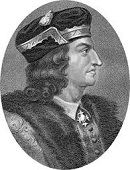
On Sept. 18, 1180 king (since Aug. 1, 1137) Louis VII the Not So Younger (b. 1120) dies, and on Sept. 18 his really young Latin-less 14-y.-o. miserable crafty hunchbacked son (no time for education now?) Philip II Augustus (1165-1223) becomes Capetian king #7 of France (until July 14, 1223); in his long reign he strives to enlarge the French royal domain (which is why they call him Augustus, although they probably mean the Augmentor?), eventually acquiring Normandy, Maine, Anjou, and Touraine at the expense of ninny King John I of England, and creating the bailii, bureaucrats that combine the functions of the English sheriffs and itinerant judges, without their roots in the local community, replacing the corrupt prevots; Philip II goes on to become known as the Maker of Paris, paving and walling it, starting construction of the Louvre, and issuing a charter for the U. of Paris, which evolves into a nice place to get a traditional liberal education (like he didn't have time for) (while Oxford tries to keep up with it?); he makes a 6-year alliance with Henry II of England so that he can take on Philip of Artois and the counts of Champagne and crush the baronial league; seeing his chance, duke Hugh III of Burgundy (1142-92) gets several nobles to change allegiance to him, pissing-off Philip II and causing him to invade Burgundy and siege Chatillon until Hugh yields, pays a high ransom for his captured son, and gives up his territorial ambitions, ending up going on the Third Crusade and becoming the most trusted ally of Richard Lionheart of England.
In 1184 the streets in front of the Louvre become the first paved streets in Paris.

In 1200 the U. of Paris is chartered by French Capetian king (1179-1223) Philip II Augustus (1165-1223); in 1210 Pope Innocent III permits its teachers to form a corporation, and in 1212 gives them a degree of independence from the bishop of Paris; in 1215 it is chartered by Pope Innocent III, who on Nov. 16, 1219 prohibits the teaching of civil (Roman law), permitting only canon law to be taught; in Dec. 1219 new pope Honorius III supports the univ. in its conflict with the bishop of Paris; on Feb. 26, 1229 street battles between students and sgts. of the provost of Paris escalate, and on Apr. 15 the univ. temporarily vacates the city in protest, while students launch the first major student strike in history over the price of wine in a tavern in the Faubourg Saint-Marcel, with some leaving for Oxford and Cambridge in England; the name "Picard" originates as an academic epithet applied to its quarrelsome students.
In 1210 the Council of Paris reacts to the shock of Latin translations of Aristotle's "Physics" and "Metaphysics" and the commentaries of learned Muslim infidel brain man Averroes by condemning Aristotle proponents Amalric of Bena (-1207) and David of Dinant (1160-1217) (who began attacking Christian doctrines incl. miracles, creation, and immortality, leading their followers to deny heaven, hell, and the sacraments), and forbidding the reading of Aristotle's "metaphysics and natural philosophy" along with any "comments" (commentaries); too bad, this only makes them more popular, and in 1215 a papal legate arrives in Paris to repeat the prohibition, which doesn't stop Aristotle from being required reading at the U. of Paris in 1255; 10 Amalricians are burned at the stake, and Amalric's bones are exhumed and burned in a Paris square; David of Dinant's book Quaternuli is condemned and burned. Beginning in this decade anti-Semitism markedly rises in France, with Jewish goods being seized and special taxes imposed (until 1289). In this decade tiles begin replacing thatched and wooden roofs on London houses.
In 1229 students in Paris launch the first major student strike in history over the price of wine in a tavern in the Faubourg Saint-Marcel.
In 1240 Roger Bacon returns to England from Paris.
In 1240 the Disputation of Paris in the court of French king St. Louis IX sees Franciscan Karaite Jewish convert Nicholas (Nicolas) Donin, who translated the Talmud and pressed 35 charges against it incl. a passage where Jesus of Nazareth is sent to Hell and boiled in shit for eternity, take on four rabbits, er, rabbis, incl. Yechiel ben Joseph of Paris (-1268), Moses of Coucy, Judah of Melun, and Samuel ben Solomon of Chateau-Thierry, accusing the Talmud of containing blasphemies against Jesus Christ, God, and the Christian religion, and obscenities, and wishing to make them chuck it so they will return to the pure Judaism of the Old Testament and become ripe for Christianity; too bad, Jew-hating Louis IX declares Donin the winner, and after a commission of Christian theologians passes judgment, 24 carriage loads of Jewish mss. incl. 10K-12K Talmuds are publicly burned in Paris in Louis IX's presence on June 17, 1244, with Louis IX uttering the soundbyte that the only way to debate with a Hell-bound Jew is to kill him "with a good thrust in the belly as far as the sword will go" - "once they start burning books it won't be long before they start burning people"? (Henrich Heine)
In 1242 the Inquisition in Paris burns the works of Jewish brain man Maimonides; 40 days later at the instigation of Jew-hating French king Louis IX, the Paris Inquisition condemns the Jewish Talmud as a vicious attack on the person of Christ, and burns thousands of copies in his presence, with Louis IX uttering the soundbyte that the only way to debate with a Hell-bound Jew is to kill him "with a good thrust in the belly as far as the sword will go"; "Once they start burning books it won't be long before they start burning people." (Henrich Heine)
In 1244 Thomas Aquinas (b. 1225) joins the Dominican Order before graduating from the U. of Naples, causing his parents to have two of his brothers kidnap and lock him up in the family castle of Roccasecca for almost two years in a vain attempt to make him resign, finally releasing him in 1245 after putting a pretty young woman in his chamber and he uses a flaming brand from the hearth to chase her out then burns the sign of the cross into the door, allowing him to go to Paris to serve his novitiate - intellectual scholars employ techniques unknown to the Yahoos in the real world?
In 1245-85 French trouvere Rutebeuf (Rustebuef) ("rude boeuf" = coarse ox, "rude oeuvre" = rustic piece of work) flourishes in Paris.
On Apr. 26, 1248 the Gothic style La Sainte-Chappele in Palais de la Cite, Paris (begun 1239) is consecrated to house Louis IX's Passion relics incl. Christ's Crown of Thorns, becoming the residence of the French kings until the 14th cent., becoming known for its stained glass collection.
In 1250 four nat. colleges are established at Paris U.
In 1250 Notre Dame Cathedral in Paris, France (begun in 1163) is finished.
In 1253-7 the Sorbonne in Paris is founded by court chaplain (to Louis IX) and Roman Catholic theologian Robert de Sorbon (1201-74) as the Community of Needy Theological Students (La Communaute des Pauvres Maitres Etudiant en Theologie), a residence hall for needy theological students; by the end of the cent. it is called La Sorbonne, becoming part of the U. of Paris, which in 1970 is split into 13 autonomous univs.
In 1300 despite all the wars, famine and disease, Dick Almighty wins out, and the pop. of Europe has grown 2.5x since the year 1000; Britain: from 2M to 5M; France: from 7M to 16M; Germany and Scandinavia: from 4M to 11.5M; Italy (incl. Sicily): from 5M to 10M; Spain: from 7M to 9M; Paris: 200K; Milan, Florence and Venice: 80K; London, Cologne and Barcelona 40K; Rome, Naples, Prague, Vienna and Lisbon: 20K; Dublin 10K; don't worry about overpop., the Black Death is just around the corner?
On May 31, 1316 after receiving his doctor of theology degree from the U. of Paris, Cesena, Italy-born Franciscan theologian Michael of Cesena (1270-1342) is elected minister gen. of the Naples chapter, and travels to Assisi, where he convokes a chapter to revise the order's constitutions, issuing the document Gravi qua premor on Aug. 21, advocating ecclesiastical poverty to be like Christ and his Apostles, pissing-off Pope John XXII, who pub. the bull Quorumdam exigit on Oct. 7, 1317, declaring heretical the belief that since Jesus and his disciples owned nothing, the Church should do likewise; in 1318 he orders 25 pesky poor-mouthing Franciscans tried by the Inquisition in Marseilles, and after all are found guilty of heresy, four are burnt alive by French king Philip V as incorrigible heretics, pissing-off Cesena and his supporters incl. Berengarius of Perpignan and William of Ockham, who are opposed by inquisitor John of Belna, who in a disputation in Narbonne in 1321 claims their views to be heretical; on Mar. 26, 1322 Pope John XXII pub. the bull Quia nonnunquam, distinguishing between dominion and simple use in a compromise attempt; in June 1322 a gen. chapter of the Franciscan Order is convoked in Perugia, deciding that Christ and His Apostles possessed no earthly goods; on Dec. 8, 1322 Pope John XXII pub. the bull Ad conditorem canonum, forcing the Franciscans to accept ownership of their property, reversing Pope Gregory IX, who ruled that all Franciscan property belonged to the Holy See; in 1323 Pope John XXII pronounces false the proposition that Christ and his apostles had owned no property (which was approved by Pope Nicholas III in 1279), making the Spirituals (Zealots) of the Order of St. Francis into heretics, subject to be burned by the Inquisition; in 1328 after stalling for a year, Cesena appears before the pope in Avignon, and is excommunicated, while his supporters flee to Naples but are forced by a storm to land in Pisa, and HRE Louis IV deposes the pope; on June 11, 1329 after the pope gains control of the Franciscan Order, the gen. council of the Paris chapter condemns Cesena's views, and he is deposed from his leadership position and replaced by Gerard Odon (Geraldus or Gerardus Odonis) (Guiral Ot) (1285-1349); in 1330 the pope issues the encyclical Quia vir reprobus, warning the faithful against Cesena, who accuses the pope of heresy in his letter Ad perpetuam rei memoriam innotescat quod ego, Fr. Michael on Nov. 25, 1330; on Apr. 25, 1331 the Franciscan chapter in Perpignan expels Cesena from the order and sentences him to life imprisonment, and he fights for his cause until his Nov. 29, 1342 death in Munich; he is officially rehabilitated in 1359; meaanwhile on Nov. 28, 1336 new Pope (1334-42) Benedict XII confirms Odonis' Constitutiones Benedictinae, which are abrogated by the gen. chapter in Assisi on June 1, 1343, restoring the 1260 Constitutions of Narbonne.
In 1326 Marsilius of Padua is forced to flee Paris.
In 1330 the Menetriers (Paris Musicians' Guild) is founded (until 1773).
The Black Death (the original Darth Vader) rockets through Europe's Internet with breathtaking speed? In Oct. 1347 a Genoese trading fleet arrives in Messina, Sicily carrying the Black Death (Bubonic Plague), caused by Yersinia pestis bacteria carried by fleas from rats; not rats but gerbils?; it also arrives in Egypt, Syria, and Cyprus; by 1351 it kills 20M-30M in Europe (a third of Europe's pop., and up to 60% in some areas), and 75M worldwide by 1361; world. pop. decreases from 450M to 350M-375M by 1400; Europe takes 150 years to return to 1347 pop. levels; it ravages China, halving its pop. from 123M in 1200 to 65M in 1400; lucky America is not affected, but not toughened up by it either?; rats didn't really spread it, because it spreads so fast from person to person?; French Franciscan Order minister-gen. (since 1329) Gerard Odon (Geraldus or Gerardus Odonis) (Guiral Ot) (1285-1349) is asked by the pop. of Messina to retrieve the relics of St. Agatha from Catania, and when they refuse he dips them in holy water and takes instead, dying of the plague on his return trip.
In summer 1349 the Great Plague reappears in Paris, where it peaks, killing up to 800 a day, and spreads to Picardy, Flanders, and the Low Countries; also in the summer it reappears in London, and spreads to Ireland, killing 25% of the pop. within a year; by the middle of the year half of the pop. of Venice is killed; by the end of the year half of England's pop. is killed, and a truce with France is called; the plague spreads to Norway when an English ship full of corpses floats into Bergen, and reaches Elbing (Elblag), Poland on Aug. 24; the Church and its credibility being challenged head-on, the main solution offered is by the Flagellants, who appear in force all over Europe (especially Germany), torturing themselves publicly, and proclaiming that the Second Coming is 33.5 years away (I been a bad, bad boy, so tan my sinful hide?), while causing trouble for Jews, the rich, the Church, and finally themselves (besides all the wounds), causing Pope Clement VI to pub. a bull condemning them on Oct. 20; "Many persons, and even young children were soon bidding farewell to the world, some with prayers, others with praises on their lips."

On Aug. 22, 1350 Philip VI of France (b. 1293) dies, and on Sept. 26 his luxury-loving boob son (by his wife Jeanne of Burgundy), the duke of Normandy John (Jean) II the Good (1319-64) ("a good knight and a mediocre king") is crowned Valois king #2 of France in Notre Dame de Reims (until Apr. 8, 1364), and stages a royal entry into Paris on Nov. 11, going on to become a spendthrift and repeatedly debase the currency, appointing brutal thieves to administer his kingdom; on Nov. 19 popular constable of France Raoul II of Brienne, Count of Edu and Guines (b. 1315) is executed in Paris on the king's orders after being released by the English to seek his ransom and rumor to have pledges his county of Guines in return for his release, ending the king's honeymoon with his nobles.
About 1350 Cambrai eclipses Paris as the center of French music.
In 1351 Notre Dame Cathedral in Paris is finished.
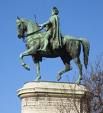

On Jan. 11, 1358 as he vies with Dauphin Charles for supremacy in France, Charles the Bad of Navarre enters Paris, and Etienne Marcel (b. 1302), provost of the Parisian merchants raises a crowd and storms the Palace of Les Halles, killing many nobles and turning them all against him; in May the dauphin orders the nobles to blockade Paris; on May 28 the Jacquerie, a peasant ("Jacques") revolt begins in St. Leu, France, fueled by war taxes and the pillages of the Brigand Cos. (demobilized soldiers), who during the summer cause a collapse of the govt. outside Paris; on June 10 several thousand Jacques storm Mello and Meaux in Beauvais, NE Paris (residence of the royal family) and are defeated, causing the tide to turn against them; in June Charles the Bad of Navarre kills Guillame Caen, leader of the Jacques; the remaining Jacques are hunted down and killed by June 24; in July Charles the Bad reenters Paris, making a bad bid for the crown, with Marcel's support, on July 22 bringing a band of hated English soldiers into Paris, causing an enraged mob to attack and drive them into the Louvre; on July 31 Marcel orders his guard to give the keys of the city to Bad Charles, but they balk, and Marcel is trampled to death on the streets by the mob; on Aug. 2 Paris opens its gates to Dauphin Charles, who pardons everybody after a little foolin' around with angry crowds; meanwhile, Bad Charles defies him and renews his alliance with Edward III.
On Mar. 24, 1359 John II signs the 2nd Treaty of London, surrending most of W France (the old Angevin lands), and agreeing to pay a ransom of 4M gold ecus; on May 25 the Estates General rejects the treaty and make preparations for a war with England; in Aug. Charles the Bad of Navarre reconciles with dauphin Charles and the king; Edward III arrives in Calais at the end of Oct. with a large army, but the dauphin issues a policy of avoiding pitched battles; Geoffrey Chaucer joins Edward III's army and goes with it to France; in Nov. Edward III takes Nogent-sur-Seine in Champagne, then unsuccessfully sieges Paris and king-crowning-city Reims in Dec., and Geoffrey Chaucer is captured; S France has been so devastated by the English that they have trouble finding food? - how about champagne?
In 1366 Pope Urban V sends legates to Paris to announce that all candidates for an arts degree at the U. of Paris have to thoroughly study Aristotle.
In 1369 Charles V the Wise of France tricks the Estates General into agreeing to make old grants of funds perpetual unless their terms are to be changed, freeing him from their control unless new taxes are needed, and transferring the financial control they grabbed in 1357 to his royal chambre de comptes in Paris.
In 1369 the Bastille (Bastille Saint-Antoine) prison at No. 232, Rue Saint-Antoine in Paris is built.
In 1376 to avoid soiling the Seine River, butchers in Paris are allowed to use the Bievre (Bièvre) (Fr. "Beaver") River nearby, with more industry moving in and turning it gradually into a polluted industrial river with a living and dead arm; in 1875 the city decides to conceal it, making it part of the sewer system.
On Apr. 15, 1521 the College of Sorbonne in Paris formally condemns the teachings of Martin Luther.
On Feb. 2, 1528 Ignatius Loyola arrives in Paris on foot, spending the next six years in loyal destitution. On Feb. 18, 1528 after returning from captivity in Madrid in 1526 and finding the Louvre uncomfortable, Francis I begins demolition of the great central tower of the Louvre to make it into a palatial residence; on Mar. 15 HE announces plans to make Paris his principal residence and begins the large hunting lodge Chateau de Madrid in Neuilly on the edge of the Bois de Boulogne.

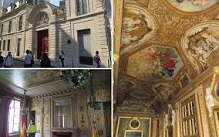
In 1710 French architect Germain Boffrand (1667-1754) begins the Hotel Amelot in Paris (finished 1713), which features an oval forecourt - a lot of what goes on there? In 1735-40 he designs the interiors of the Hotel de Soubise in Paris, pioneering the Rococo (Louis XV) style. In 1745 he pub. Livre d'Architecture, which attempts to strike a balance between French academic classicism, Italian Baroque, and his new Louis XV Rococo.


In Aug. 1744 Louis XV, who took personal command of the army in the spring offensive in the War of Succession and takes his babe Madame de Chateaureoux (b. 1717) along with him becomes seriously ill, sending her packing, allowing the French mobs to show their hatred for her by throwing rotten veggies at her carriage and hissing her, making her ill, and when he recovers and calls her back in Dec., she rises too quickly from her sickbed and dies of pneumonia; he vows to replace the ruined church of the Abbey of St. Genevieve in the Latin Quarter of Paris, entrusting Abel-Francois Poisson, Marquis de Marigny with the task, and in 1755 he commissions French architect Jacques-Germain Soufflot (1713-80) to design a new church, which begins construction in 1758, and is finished in 1790 in neo-classical style, with a facade modeled on the Pantheon in Rome, and a Bramante-style dome; in 1790 the Church of St. Genevieve in Paris (begun 1758) is finished and turned into the Pantheon (Panthéon) (Gr. "Temple of All the Gods"), enshrining tombs of famous Frenchmen, starting with Mirabeau on Apr. 4, followed by Voltaire on July 11.
In 1755 the moat-skirted octagon-shaped Place de la Concorde (Place Louis XV) at the E end of the Champs-Elysees next to the Tuileries Gardens, designed by Ange-Jacques Gabriel (1698-1782) is begun (finished 1772), becoming the largest in Paris; it originally features an equestrian statue of Louis XV commissioned in 1748 by the city of Paris, sculpted by Edme Bouchardon and Jean-Baptiste Pigalle; during the French Rev. the statue is torn down and the area renamed Place de la Revolution, where Louis XVI becomes its first neckless guest on Jan. 21, 1793.

On Mar. 17, 1782 Italian violinist Giovanni Battista Viotti (1755-1824) debuts in Paris, becoming an instant hit, going on to found the Theatre de Monsieur in 1788 under the patronage of the king's brother the comte d'Artois; too bad, after the French Rev. his royal connections backfire, causing him to flee to London in 1792, where he is also a hit, but after Britain goes to war with France he is expelled, ending up in Paris again; he owns a 1709 violin by Antonio Stradivari called the Viotti Stradivarius, given to him as a love gift by Catherine II the Great.
On Oct. 5, 1782 after John Jay sends secret envoy Benjamin Vaughan to ask for it, Lord Shelburne sends a note to commissioner Richard Oswald changing his commission to negotiate with "the said colonies and plantations" to "the colonies under the title of 13 united states", and formal peace negotiations begin in Paris between the formally recognized U.S. and Britain; fearing that the French are angling for a separate peace with the British, John Jay persuades Franklin to do the same; the new U.S. offer allows Britain free navigation rights on the Mississippi; John Jay arrives in Paris, along with Adm. Howe's secy. Henry Strachey, fresh from the British V at Gibraltar, and negotiations get serious starting on Oct. 30 (Adams' 47th birthday), haggling over fishing rights off Newfoundland ("New England's ancient stake in the sacred codfish" - Adams), prewar debts, the western boundary, and compensation for British loyalists in America.
On Nov. 30, 1782 Preliminary Peace Articles are signed at the British suite at the Grand Hotel Muscovite in Paris (the U.S. secy. is Ben Franklin's grandson Temple Franklin), acknowledging the U.S. as "free, sovereign and independent", and ending the Am. War of Independence, but with final agreement depending on a Franco-British settlement, which takes 9 mo.; the Northwest Territory (S and W of the Great Lakes, NW of the Ohio River, and E of the Mississippi River, incl. the future states of Ohio, Ind., Ill., Mich., Wisc. and part of Minn.) is ceded by Britain to the U.S., becoming its first possession; meanwhile Franklin tries to fix things up with the French for acting without consulting them, on Dec. 25 writing "one of the most famous of all diplomatic letters", implying that making the "little misunderstanding" public would help Britain divide them, even drive the U.S. into an alliance with Britain, which causes stunned French minister Vergennes to crumble, commenting "We shall be but poorly paid for all that we have done for the United States and for securing to them a national existence" - no wonder the French have a love-hate relationship with Yankees?

In 1782 Louis XVIII's triple-chinned ex-chef (of the Prince of Conde and the Count of Provence) Antoine B. Beauvilliers (1754-1817) opens the Taverne Anglaise Restaurant in the Palais Royale in Paris, becoming the first luxury restaurant in Paris, catering to aristocratic clientele with mahogany tables and fine linen tablecloths, crystal chandeliers, elegantly-dressed waiters, fine cuisine, and an extensive wine cellar; in 1788 he moves to the Gallery de Valois near the Cafe de Chartres, calling it Restaurant Beauvillers Le Magnifique; after being forced to close in 1795, he opens another restaurant in Paris that closes in 1825.




Do you know the way to Hot Air Bay? On June 4, 1783 the Montgolfier Brothers Joseph-Michele Montgolfier (1740-1810) and Jacques-Etienne Montgolfier (1745-99) publicly demonstrate their paper-lined linen hot air balloon, which rises to a height of 3K ft. at Annonay, France in a 10-min. 1-mi. flight; on Aug. 27 Parisian physicist Jacques Alexandre Cesar (César) Charles (1746-1823) launches a 13-ft.-dia. silk balloon (constructed under his supervision by A.J. and M.N. Robert) filled with hydrogen in Paris in front of 50K spectators; it floats at 3K ft. for more than 45 min. and lands in a village 16 mi. away, where the spooked villagers attack it with stones and knives; on Sept. 19 the Montgolfier Brothers conduct another demo in Versailles, witnessed by Louis XVI and Marie Antoinette, where a duck, rooster, and sheep become the first living passengers, traveling 2 mi. in 8 min., with max. alt. of 1.5K ft, pissing the king off with the dense smoke they deliberately generate in the belief that it's what causes the buoyancy, later learning that it's heat; on Oct. 15 French daredevil physician Jean Francois Pilatre de Rozier (1754-85) makes the first tethered balloon ascension, repeating the demo on Oct. 17 before a group of scientists, then reaching 324 ft. on Oct. 19; on Nov. 21 (2 p.m.) champagne-toting de Rozier and army officer Marquis Francois Laurent le Vieux d'Arlandes (1742-1809) make the first untethered human flight, reaching a peak alt. of 500 ft. and traveling 5.5 mi. in 25 min. from the Bois de Boulogne in Paris in the presence of Louis XVI and a huge crowd, across the Seine River to the Butte-aux-Cailles; the next day Benjamin Franklin et al. sign the official certification at Passy; on Nov. 31 Jacques Charles (financed by Franklin) flies in his hydrogen balloon, while gouty Franklin watches from his carriage near the Tuileries Gardens; balloon exhibition flights soon become the rage in Paris; when asked what was the practical use of these balloon thingies, Franklin replies "What is the use of a newborn baby?"; the power of a mere individual to go over the king's head and attract large crowds is a giant leap for popular democracy, making the French Rev. inevitable, and, combined with the success of the U.S., it coulda gone better if only they hadn't dabbled with the powder keg of godless atheism?
In 1785 it is decided to move the stinking Cemetery of the Innocents in Paris to the limestone quarries S of the city, taking two stinking years.

In 1786 the Paris Catacombs underneath Paris near Montparnasse (created in 1738 when limestone is quarried) have their roofs strengthened after some parts of Paris begin to sink, and begin to be filled with bodies removed from other burial grounds incl. recently closed (1780) Saints-Innocents in nightly processions, eventually housing 6M, the bones arranged in varied designs along the sides of the galleries.










On July 2, 1789 dirty bastard Marquis de Sade (1740-1814), who is imprisoned in the Bastille yells to the crowds outside "They are killing the prisoners here!", causing a riot, after which on July 4 he is transferred to the Charenton insane asylum near Paris, missing out on the July 14 storming of the Bastille, although his estate in Lacoste is sacked by a mob later this year; he is finally released in 1790 after the assembly abolishes the instrument of lettre de cachet that had been used to imprison him sans charges, divorces his wife and hooks up with actress Marie-Constance Quesnet, with whom he spends the rest of his life, growing extremely obese and calling himself "Citizen Sade", getting elected to the Nat. Convention representing the far left despite his aristocratic background. Catastrophe theorists here's your butterfly flapping its wings and causing a hurricane? On July 12 reformer French minister Jacques Necker is suddenly fired by the king, and failed French lawyer Camille Desmoulins (1760-94) has his 15 min. of fame when he loses his usual stammer and jumps up on a table on a cafe outside the Palais Royal and utters the immortal soundbyte: "This dismissal is the tocsin of the St. Bartholomew of the patriots!", after which he draws two pistols and declares that if the pigs are going to take him they will have to take some bullets first, triggering riots in Paris, which on July 13 leads to a partisan militia, later becoming the Nat. Guard being formed; Desmoulins is now a celeb, and becomes a writer-journalist, going on to pub. Discours de la Lanterne aux Parisiens, which quotes John 3:20 ("He that does evil hates the light"), causing him to become known as the "Lanterne Prosecutor", going on to pub. the pro-violence Histoire des Revolutions de France et de Brabant (until July 1791), making him rich and famous; meanwhile on July 12 wax heads of Jacques Necker and the Duc d'Orleans made by Dr. Philippe Curtius (1741-94), mentor of Madame Tussaud are carried in a protest march. Prison break! Prison break! Those pipes are the way out? On July 14 (Tues.) (Bastille Day) after the prisoners cry to be released, the 14th cent. crenelated Bastille fortress prison in Paris falls after the soldiers refuse to fire on Parisian citizens and they storm it and release all seven prisoners inside (they leave a copy of Nostradamus' "Centuries" open to the Preface on a table for 10 days to allow people to file past and read how their rev. has been predicted?); aided by French Royal Guard deserters they capture and kill Bastille gov. (since 1776) Bernard-Rene (Bernard-René) Jourdan de Launay (b. 1740), then shoot and murder Jacques de Flesselles (b. 1721) at the Hotel de Ville, who becomes the last provost of the merchants (mayor) of Paris (since 1785); the king is awakened in the middle of the night by his chamberlain to tell him the potty news, and now that he has lost the support of his army he knows he's kaput, and writes in his diary "Nothing", meaning he didn't go hunting?; on July 15 the electors of Paris abolish the French feudal system and set up a Commune after Louis backs down and orders his troops out of Paris; Marquis de Lafayette becomes cmdr. of the Nat. Guard (originally proposed by Comte de Mirabeau), and bookish painter-tragedian-scientist (expert on the history of Science) Jean-Sylvain Bailly (1736-93) is elected mayor of Paris (until Nov. 1791 1791); on July 17 amid a gen. panic about a "famine plot" by the aristocrats (10%) to starve or burn-out the rest of the pop., causing peasants and townfolk to unite and mobilize, the king recalls Necker; the French Tricolor Flag is adopted, white for France, blue and red for Paris; on July 20 peasants arise throughout France, beginning the Grande Peur (Fr. "great fear"), which ends on the night of Aug. 4 with the nobles and clergy surrendering their feudal rights and privileges, ending feudalism in France and kicking the manorial lords out of Dauphine, Provence, Burgundy, et al.; Burgundy, a province since 1678 is split up into the depts. of Ain, Cote d'Or, Saone-et-Loire and Yonne; the smarter French nobles begin skedaddling from France in the Emigration of the Nobles - it's time to get outside and grow something?
Beyond the Yellow Brick Road? On Aug. 10, 1792 popular demonstrations lead to the storming of the Tuileries Palace, the royal residence on the right bank of the Seine River in Paris, and the royal Swiss Guard (created 1616) shows their loyalty by defending it, losing 800 KIA; all functions of the monarchy are suspended, and not only is the king's veto power quashed, but the Nat. Legislature votes to enact all legislation he previously vetoed, and calls for a convention elected by universal male suffrage to enact a new constitution; the poor royal family is confined to tower of the the gloomy Square du Temple (old Knights Templar house) in Paris; La Carmagnole, a song written after the storming of the Tuileries, consisting of 13 2-line stanzas ridiculing the king and queen becomes popular until the end of the Terror in 1794; "Dansons la carmagnole,/ Vive le son, vive le son;/ Dansons la carmagnole,/ Vive le son du canon".
In 1792 Gouverneur Morris, who has been in Paris since 1789 and kept a Diary of the French Rev., 1789-93 becomes U.S. minister to France (until 1794).
On Apr. 1, 1795 bread riots in Paris are accompanied by monarchist agitation and the arrival of some emigres.
On Oct. 5, 1795 (Vendemiaire 13) (Mon.) the Day of the Sections sees a royalist uprising in Paris stopped by an army unit led by Napoleon Bonaparte (1769-1821) and his "whiff of grapeshot", a cannonade from the Church of St. Roch, which kills 200; the Convention votes that relatives of emigres are barred from holding office and then dissolves.
On Oct. 25, 1795 the French govt. establishes the Institut de France in Paris to replace the abolished academies, which goes on to incl. five learned academies starting with the Academie francaise (founded 1635) (which was suppressed in 1693 but is restored in 1803), Academie des inscriptions et belles-lettres (1663), Academie des sciences (1666), Academie de peinture et de sculpture (1648), academie de musique (1669), Academie d'architecture (1671), and Academie des sciences morales et politiques (1795), going on to manage 1K+ foundations by modern times.
In Nov.-Dec. 1795 Parisian workers, esp. in the printing trades strike.
In 1795 the Paris Conservatoire de Musique is founded.
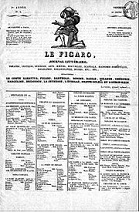
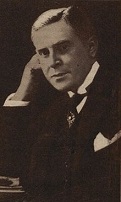
On Jan. 15, 1826 Le Figaro satirical weekly newspaper is founded in Paris, France, named after the 1778 Pierre Beaumarchais play, with the motto "Without the freedom to criticize, there is no true praise"; on Nov. 16, 1866 it becomes a daily newspaper, with a circ. of 56K copies, highest in France, and a royalist ed. line; in 1922 it is purchased by Corsican-born French perfume magnate Francois Coty (Joseph Marie Francois Spoturno) (1874-1934) (relative of Napoleon Bonaparte); by WWII it becomes France's #1 newspaper, going on to become the conservative voice of the upper middle class and one of two French newspapers of record after Le Monde, reaching a modern-day circ. of 313K.

On July 29, 1836 the 164' x 148' x 72' (50m x 45m x 22m) Arc de Triomphe (commissioned by Napoleon on Aug. 15, 1806 after the V at the Battle of Austerlitz) on the right bank of the Seine River in Paris is completed at the center of a duodecagonal configuration of 12 radiating avenues.

In the 1850s new emperor Napoleon III hires city planner Baron Georges-Eugene Haussmann (1809-91) with instructions to make Paris the most beautiful city in Europe, granting large tracts of land near the city center to him and his financial backers, driving the pop. to the edges of the city, incl. Clichy, La Villette, and Montmartre, the last ending up as a popular drinking area since it is outside the city limits and free of Paris taxes, and the local nuns make wine, going on to become the center of the decadent cabaret nightlife; meanwhile Haussmann reshapes Paris into broad Paris Boulevards and builds the 2,155-acre Bois de Boulogne park on the W side of Paris is founded on the site of the Foret de Rouvray in 1852-8, later containing the Auteuil and Longchamps race courses and the Jardin d'Acclimation; by the 21st cent. it is a park of sin for money, straight and gay; the city eventually grows to 4,082 streets.
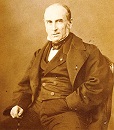
On May 15-Nov. 15, 1855 the first Exposition Universelle (World's Fair) is held in Paris, organized by Pierre Guillaume Frederic le Play (1806-82), and attracting 5M visitors, incl. Queen Victoria; it creates the 1855 Bordeaux Wine Official Classification, assigning the classification of premier cru (first growth) to Chateau Latour, Chateau Lafite Rothschild, Chateau Margaux, and Chateau Haut-Brion, all located in Medoc except Haut-Brion, which is in Graves; the Manny Reaper beats the McCormick Reaper, causing Cyrus McCormick to sue for patent infringement, hiring atty. Reverdy Johnson, while John H. Manny hires George Harding, Edwin M. Stanton, and young Abraham Lincoln, who ends up being told to sit in the audience because he looks like a "long-armed baboon" and dirty clothes, humiliating him, but forcing him to become a better lawyer?; Manny wins.

On July 5, 1855 the Theatre des Bouffes Parisiens at 4 Rue Monsigny in Paris opens with the musical operetta "Les Deux Aveugles" by German-born Jewish former cellist Jacques Offenbach (1819-80), moving on Dec. 29, 1856 to the location of the Theatre Conte, with Offenbach coining the term "opera bouffe" to describe his works, which are full of comedy, parody, satire and farce.





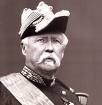






Tweedly-Dee, Tweedly-Dum, Get Ready, Cuz Here I Cum? On July 13, 1870 the Ems Telegram (Dispatch) is sent by Corsican-born French diplomat Vincent, Count Benedetti (1817-1900) to the king of Prussia at Ems, demanding him to order German prince Leopold of Hohenzollern to withdraw his candidacy for the Spanish throne and never renew it; seeing his chance, Prussian chancellor Otto Eduard Leopold von Bismarck (1815-98) leaks it (after modifying it to be more provocative), with the implication that the Frog has insulted the king, which is taken by the French as proof that the king has insulted their minister, causing diplomatic relations to become kaput; on July 19 (Tues.) after Bismarck dares them to make the first move, France declares war on Prussia, beginning the Franco-Prussian (Franco-German) War (ends May 10, 1871), the last 19th cent. war between the Euro powers, in which the Prussians followed by the French first use dynamite; Prussia then eagerly invades France, with regiments from Bavaria, Saxony, and Wurttemberg, the Prussian armies led by Field Marshal Helmuth Karl Bernhard Graf von Moltke (1800-91); in Paris U.S. minister (1869-77) Elihu Benjamin Washburne (1816-87) protects the delegations of the German states with the U.S. flag; meanwhile on Aug. 4 the prancing Prussians defeat the French at the Battle of Weissenburg, the Battle of Spicheren Heights near Saarbrucken on Aug. 5-6, and the (Second) Battle of Worth (Wörth) on Aug. 6, separating the N and S flanks of the French army, after which the incompetence and defeatism of marshal (since 1864) Francois Achille Bazaine (1811-88) seals their fate starting on Aug. 14 with the Battle of Colombey-Nouilly, where the Prussians attack the French rearguard as they try to withdraw from Metz, followed on Aug. 16 by the Battle of Mars-La-Tour (Vionville) in NE France, the one chance the French had of gaining a V, when their entire 120K-man French army is stumbled upon by two lousy Prussian corps (66K men) and held for a whole day, allowing the rest of the Germans to close in and cut off their withdrawal route from Metz; on Aug. 18 the Battle of Gravelotte (Gravellot-St. Privat) in Lorraine 7 mi. W of Metz between Metz and the French-German frontier, the largest battle of the war sees 113K retreating French under Insane Bazaine cornered by 188K Germans under Field Marshal Helmuth von Moltke, then win a tactical V at the cost of 12K casualties (vs. 20K for the Germans), but instead of counterattacking and breaking out of the hole they're in after all that bloodshed, they turn tail and retreat back to Metz, where they give up after a 2-mo. siege, proving to be the strategic D and achilles heel of the whole francois bazaine war; on Aug. 30 the Battle of Beaumont sees a 120K-man French army under Napoleon III and his Field Marshal Marie Edme Patrice Maurice de MacMahon, 1st Duke of Magenta (1808-93) caught and defeated by 200K Germans while en route to relieve Metz, causing them to retreat to the once formidable Sedan Fortress, only to be encircled then defeated on Sept. 1-2 at the Battle of Sedan, surrendering 85K French troops and 39 gens. plus Napoleon III himself, who is deposed by the legislature at the urging of Jules Favre, with only Normandy remaining loyal; on Sept. 2 an armed force of rev. workers led by Louis Auguste Blanqui (1805-81) (who spent 1839-48, 1848-59, and 1861-5 in prison for rev. activities) topples the French Second Repub., and on Sept. 4 the French Third (3rd) Repub. (ends 1940) is proclaimed from the Hotel de Ville by Leon Gambetta (1838-82), who becomes pres. #1, with Jules Favre as vice-pres. and minister of foreign affairs, conducting peace negotiations with Germany; too bad, Bismarck refuses to recognize it, and the Huns, er, Prussians begin the Siege of Paris on Sept. 19 (ends Jan. 28, 1871), destroying the Tuilieries (royal palace) by cannon fire; in Sept. Gambetta escapes from Paris in a balloon built and piloted by Gaston Tissandier (1843-99), and establishes HQ in Tours, attempting to reorg. the French army and becoming dictator of France for 5 mo.; on Oct. 30 revolutionaries break into the Hotel de Ville (City Hall) in Paris and capture the govt. of national defense, making demands for a communard govt. until soldiers entering through a secret underground tunnel (built in 1807) rescue them; in early Nov. Verdun on the Meuse River, the strongest fortified town in E France falls after a 6-week siege; on Nov. 27 the Germans defeat the French at the Battle of Amiens (Third Battle of Picardy) (pr. AM-ee-yuh), and the citadel surrenders on Nov. 30; Orleans is occupied by the Krauts, er, foreign invaders from Oct. 11-Nov. 9, then from Dec. 5 to the end of the war; Metz (sieged Aug. 19-Oct. 29) and Strasbourg (sieged Aug. 15-Sept. 28) surrender, and Gambetta calls marshal (since 1864) Francois Achille Bazaine a traitor for surrendering Metz, pissing him off enough to resign, and in 1873 he is convicted of capitulation and sentenced to death, commuted to 20 years in Ile St.-Marguerite, but he escapes to Genoa in 1873, then spends the rest of his wound-racked life in Madrid; during the siege of Paris the Pigeon Post of Paris gets mail into the city; U.S. Civil War nurse Clara Barton (1821-1912) works with the new Internat. Red Cross Society to help wounded soldiers; in Nov. aeronaut Wilfrid de Fonvielle (1824-1914) escapes Paris in a balloon and lands in London, giving a series of lectures on how great the Third Repub. is; scientist Louis Pasteur (b. 1822) tries to volunteer for military service but the authorities tell him he can best serve them in the lab?

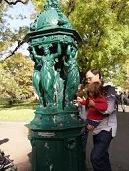
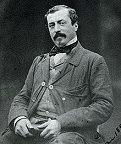
In 1872 Nantes-born French sculptor Charles-Auguste Lebourg (1829-1906) begins sculpting 50 small cast-iron Wallace Fountains (drinking fountains), financed by English art collector Sir Richard Wallace, 1st Baronet (1818-90), which are sited throughout Paris on the busiest sidewalks and give Paris its character, also in Lisburn.
In 1881 Paris begins building a city-side compressed air distribution system (finished 1889), which distributes 5-6 bar air over 900km of mains, serving 10K customers; it operates until 1994.


On Mar. 31, 1889 French engineer ("the Magician of Iron") Alexandre Gustave Eiffel (Bonickhausen dit Eiffel) (1832-1923) unfurls the French tricolor from atop his $1M 7.3K-ton 1,056-ft. (300.65m) 1,652-step Eiffel Tower ((AKA La Dame de Fer) in Paris on the Champ de Mars (begun 1887), officially marking its completion in celebration of the centennial of the 1789 French Rev. as the entrance arch for the Exposition Universelle, becoming the tallest man-made structure on Earth (2x as tall as the Washington Monument) until the Chrysler Bldg. in 1930; initially condemned by critics as a "monstrosity" and a disgrace to Paris, who form a committee to have it removed, the cost of construction is recovered from sightseers' fees during the first year of operation; originally issued a 20-year permit, set to be dismantled in 1909, it is saved for use as a radio tower, and France's first radio program is broadcast from it in 1921; during the Nazi occupation in 1940-4 the French almost demolish it to prevent the Nazis from using it for communications - I fell off the Eiffel?
In 1895 the first public film show in Paris is held at the Hotel Scribe.
On Apr. 14-Nov. 12, 1900 the 1900 Paris World Exhibition (Exposition Universelle) is held in the Paris Metro bldg., with 76K exhibitors and 51M visitors; Campbell's Soup is awarded a gold medal; Art Nouveau is pushed as the new thing for the 20th cent.; Rudolph Diesel's new diesel engine (which runs on peanut oil) takes the grand prize; the Palace of Electricity features a dazzling display of electric lights.



The Nazis wash the gay right out of Gay Paris' hair? On June 14, 1940 (6:00 a.m.) after French military gov. Gen. Pierre Hering (1874-1963) declares it an open city on June 12, and the French cease military activity in suburban towns to give them a free path, the French weep as the Germans occupy Paris after 2M have already fled, leaving 700K, who are told of a new 8:00 p.m. curfew; at 9:45 a.m. the German Fourth Army under Gen. von Kluge triumphantly marches down the Champs-Elysees to mock the Nov. 1918 French victory march; PM Paul Reynaud resigns, is arrested and sent to Ft. du Portalet, transferred to German custody in 1942 and held in Germany until the end of the war; the SS sets up shop headed by Col. Helmut Knochen (1910-2003); Austrian-born Jewish "The Eyewitness" novelist Ernst Weiss (b. 1882) commits suicide in his Paris apt.; the Nazis order all French films made prior to 1937 destroyed, causing Henri Langlois, 1936 founder of the Cinametheque Francois to smuggle huge numbers of films and documents to unocupied France, incl. Charlie Chaplin's "The Great Dictator". On June 16 deputy PM Marshal Philippe Petain threatens to resign if the French cabinet doesn't ask for an immediate armistice, and PM Paul Reynaud asks Britain to release France from its agreement not to make a separate peace, and they agree, but propose an Anglo-French Union, which the cabinet rejects, causing Reynaud to resign, and Petain to form a new govt. and ask Germany for an armistice at 11:00 p.m.; on June 17 (a.m.) Hitler learns of it, and jerks his knee before stepping backward while cameraman Walter Frentz (1907-2004) photographs him, causing Canadian producer John Grierson to loop it and make Hitler dance a jig, whipping-up ridicule; on June 17 (p.m.) after Petain broadcasts the news, Winston Churchill broadcasts a speech, with the soundbyte: "Whatever has happened in France makes no difference to our actions and purpose. We shall do our best to be worthy of this high honor. We shall defend our island home, and with the British Empire we shall fight on unconquerable until the curse of Hitler is lifted from the brows of mankind. We are sure that in the end all will come right"; on June 20 on Hilter's orders the Armistice site is destroyed incl. a German eagle impaled on a sword and a large stone tablet reading "Here on the eleventh of November 1918 succumbed the criminal pride of the German Reich, vanquished by the free peoples which it tried to enslave; a statue of Foch is left intact to mock him; the Armistice carriage is taken to Berlin, not surviving the war.


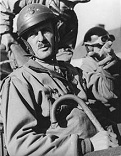
On Aug. 18, 1944 the Germans transport 2,453 French political prisoners from prisons in Paris to Ravensbruck and Buchenwald via Nancy; less than 300 survive the war. On Aug. 19 the Paris Uprising (Battle for Paris) (ends Aug. 25) sees the former Paris police raise the French tricolor flag and sing the Marseillaise, firing at German troops and taking 600 POWs; on Aug. 20 (a.m.) they occupy the Hotel de Ville; by Aug. 21 7K armed French Resistance forces join them, awaiting the arrival of the Allies. Paris becomes gay again? On Aug. 23 the all-new 200K-man French Forces of the Interior (FFI) under Gen. Marie-Pierre Koenig (1898-1970) free all French civilian prisoners in Paris; meanwhile the Germans make a last show of strength, ousting Resistance forces from the Grand Palais and attacking them in the city center, killing many. On Aug. 23 (night) French troops reach Rambouillet, France 30 mi. SW of Paris. On Aug. 24 French troops under Col. Pierre Armand Gaston Billotte (1906-92) enter S Paris through the Porte d'Orleans, causing tens of thousands to flood the streets welcoming them with goodies; on Aug. 25 (7:00 a.m.) the French Second Armored Div. under Gen. Philippe Francois Marie Leclerc de Hauteclocque (1902-47) liberates Paris, while pockets of Germans resist, with 50 KIA defending the French Foreign Office Bldg. on the Quai d'Orsay, and a column of German POWs machine-gunned by madass partisans as they are marched around the Arc de Triomphe; collaborators are savagely murdered on sight; the Germany army has by now sustained 400K casualties and lost 1.3K tanks, 3.5K aircraft, and 1.5K artillery; at 2:30 p.m. German military gov. of Paris (since Aug. 7) Gen. Dietrich von Choltitz (1894-1966), who cold-titted several direct orders from Hair Hitler to burn the city before evacuation, Hitler once uttering the soundbyte "Brennt Paris?" (Is Paris Burning?) to him (making Choltitz's name live forever as the savior of Paris?), surrenders his 17K men without a fight to French Gen. Philippe Leclerc de Hautecloque (1902-47) and FFI leader (a Communist) Henri Rol-Tanguy (1908-2002) at the Gare Montparnasse Train Station in the 15th Arrondissement; at 4:00 p.m. poof-his-acne-healed Gen. Charles de Gaulle makes a triumphal entry into Paris, reaching the Hotel de Ville and giving a Paris Liberation Speech from the front window; the capture of Paris costs 500 Resistance fighters and 127 civilians killed; on Aug. 26 Charles de Gaulle marches down the Champs Elysees along with 15K troops of the U.S. Fourth Infantry to wild jubilation - if you can't get lucky today, you must be uglier than what?

On Dec. 19, 1944 Le Monde (Fr. "The World") center-left daily afternoon paper is founded in Paris, France at the request of Charles de Gaulle, becoming one of two French newspapers of record along with "Le Figaro", reaching a modern-day circ. of 323K.
On Mar. 21, 1968 a student is arrested during a demonstration against the head office of the Am. Express in Paris, causing student outbreaks to begin at the U. of Nanterre Prague has a whole spring, France gets just May? On May 2, 1968 (Thur.) the French May of 1968, a near-repeat of the 1789 French Rev. begins when student outbreaks that began on Mar. 22 spread to Paris' Latin Quarter (Sorbonne et al.), and erupt into student riots; on May 3 the police evacuate the Sorbonne after arresting 600 (100 injured), just making them madder; on May 6 (Mon.), AKA Bloody Monday hundreds of thousands of students riot; on May 10 and May 11 ("Night of the Barricades") students in the Latin Quarter erect cobblestone barricades, fly red flags, and overturn 188 cars, burning many of them with Molotov cocktails, injuring 1K, incl. 251 police; on May 11 the revolt spreads to 10M French workers, who begin striking; on May 18 pres. Charles de Gaulle cuts a visit to Romania short to return to Paris, and calls in troops, causing the students' rev. spirit to begin to dissipate, and the strikes to stop by May 27; after philosopher Jean-Paul Sartre (1905-80) is arrested for civil disobedience, de Gaulle intervenes and pardons him, with the soundbyte "You don't arrest Voltaire"; on May 24 de Gaulle gives a radio address, calling for a referendum on reforms to end the violence, with the soundbyte "Back me or sack me"; on May 24 protesters set fire to the Paris Bourse after French-born German Jewish student Daniel Marc Cohn-Bendit ("Danny the Red") (1945-), who took part in the initial revolt in Nanterre is exiled as a threat to public order; after trade unions sign major agreements on wages and working conditions, workers begin returning to the job on May 27; on May 30-31 de Gaulle dissolves the French nat. assembly (parlement) and proclaims new gen. elections, which are held on June 23-30 and are a V for his Gaullists, giving them 358 of 487 seats, a repudiation of Communists and other radicals, causing his govt. to become stronger than before the big ruckus; meanwhile on Apr. 29 a Renault factory on Seguin Island is struck for 33 days until the govt. recognizes their union; after things calm down, de Gaulle appoints former agriculture minister Edgar Faure as education minister and gets a new law enacted to reform higher education, dissolving the U. of Paris and creating 13 new univs. in its place, incl. Paris-Sorbonne U., Pantheon-Assas U., Rene Descartes U., Pierre and Marie Curie U., Denis Diderot U., Pantheon-Sorbonne U., Sorbonne Nouvelle U., U. of Vincennes in Saint-Denis, Paris Dauphine U., U. of Paris Sud, U. of Paris Ouest, U. of Paris Est, and U. of Paris Nord.



On Jan. 31, 1977 the Centre National d'Art et de Culture Georges-Pompidou (Georges Pompidou Nat. Center for Art and Culture) in Beaubourg, Paris opens, constructed of concrete slabs enclosed in glass and supported by a network of pipes, designed by English architect Richard George Rogers (1933-) and Italian architect Renzo Piano (1937-), becoming the #1 tourist attraction in Paris (5.2M visitors in 2013), housing the Bibliotheque Publique d'Information (Public Info. Library), Musee National d'Art Moderne (largest modern art museum in Europe), and the IRCAM center for music and acoustic research.

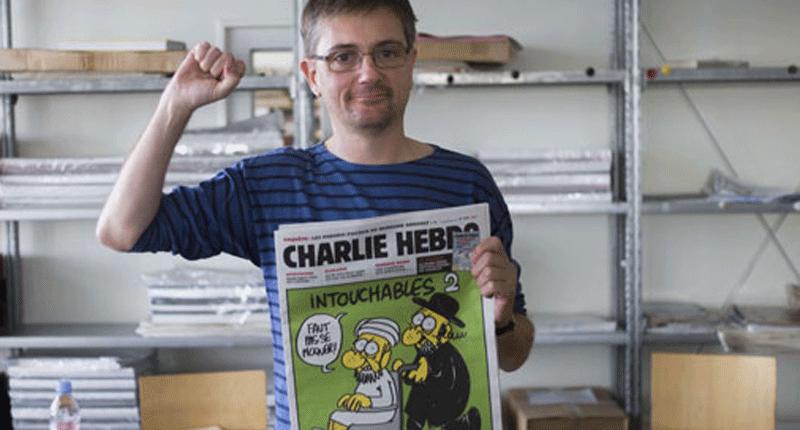

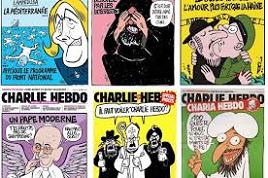
On Jan. 7, 2015 (11:30 a.m. local time) the Charlie Hebdo Massacre sees a terrorist attack by black-hooded vest-wearing Allah Akbar-shouting Kalashnikov-carrying Muslim al-Qaida members Said Kouachi, Cherif Kouachi, and Hamyd Mourad at the Charlie Hebdo newspaper HQ in Paris N of Notre Dame Cathedral and E of the Arc de Triomphe, known for satirizing Muhammad kills 10 staffers incl. ed.-in-chief Stephane (Stéphane) "Charb" Charbonnier (b. 1967), and cartoonists Cabu, Wolinski, and Tignous, along with two police officers, incl. married Muslim officer Ahmed Merabet (b. 1965), injuring 11, becoming the worst terrorist attack in France since 1995; they were in an editorial meeting before the attack; Amedy's armed dangerous Muslim convert wife Hayat Boumeddiene remains on the loose; the lights on the Eiffel Tower are extinguished in memorial; one of the terrorists shouts "The Prophet has been avenged"; the offices were firebombed in 2011; Pres. Obama calls the attack "cowardly" and "evil"; French PM Francois Hollande calls it "an exceptional act of barbarism committed against a newspaper", and notes that France is in "shock", adding "We need to show we are a united country", but ostriching with the statement that the attacks "have nothing to do with Islam"; Israeli PM Benjamin Netanyahu utters the soundbyte: "The main goal of Islamic terrorism is to destroy societies, and countries, to stamp out human civilizations based on freedom and the culture of choice, and to impose in its place a fanatical dictatorship which returns humanity to another era"; 100K demonstrate across France to protest the killings; at 10:40 p.m. police raid the last known addresses of the terrorist brothers and arrest relatives; on Jan. 8 Donald Trump issues the tweets: "If the people so violently shot down in Paris had guns, at least they would have had a fighting chance... Isn't it interesting that the tragedy in Paris took place in one of the toughest gun control countries in the world?... Remember, when guns are outlawed, only outlaws will have guns!"; on Jan. 9 the Kouachi brothers hole-up in a printing complex in Dammartin-en-Goele before being killed by police, while 3rd suspect Amedy Coulibaly takes five hostages at the Hyper Cacher Jewish kosher supermarket in Porte de Vincennes, killing four before the police kill him, justifying the massacre as revenge for attacks on ISIS, while 30 others hide in the freezer for five hours, causing French pres. Francois Hollande to call it "an appalling anti-Semitic act"; al-Qaida (AQAP) in Yemen announces that it planned the attacks, and claims that more are coming in Europe and the U.S., causing the FBI to issue new terror warnings for Americans; maps of Jewish schools in Paris are found in Amedy's car, causing 5K police to be deployed to protect them; on Jan. 11 1.5M (biggest since Victor Hugo's 1885 funeral) attend a rally in Paris, incl. 50 world leaders (except Pres. Obama and Vladimir Putin) (incl. some known for suppressing free speech); Francois Hollande asks Benjamin Netanyahu and Mahmoud Abbas not to attend; on Jan. 11 French PM Manuel Valls declares war "against terrorism, against jihadism, against radical Islam, against everything that is aimed at breaking fraternity, freedom, solidarity", bemoaning the ever-growing exodus of Jews from France with the soundbyte that if the Jews all leave France in the wake of anti-Semitic terror, "The French Republic will be judged a failure"; too bad, he blames France's "apartheid regime" for terrorism, while the French govt. rushes to pass tough new laws against freedom of speech, along with a new surveillance law in May that gives the govt. broad powers to monitor phone and Internet traffic; meanwhile ex-French PM Dominique de Villepin claims that the West created Islamic terrorism, with the soundbyte that ISIS is "the monstrous child of inconstancy and arrogance of Western policy", and that "In 2001 there was only one central terrorist group, today there is a dozen" because "we have multiplied them... The war against terrorism is just like adding fuel to the fire"; on Jan. 11 the Hamburger Morgenpost in Germany is firebombed after it reprints the Muhammad cartoons; on Jan. 12 White House press secy. Josh Earnest utters the soundbyte that Pres. Obama (who was against Charlie Hebdo's cartoons in 2012) will try to stop anti-jihadist articles from being pub. when it might cause a jihadist attack against U.S. forces; too bad, French Muslims celebrate the massacre, and Muslim schoolchildren treat a moment of silence in the classroom with contempt; the survivors crank out the next issue on its regular date of Jan. 15, with a circ. of 3M in 16 languages instead of the usual 60K, with another 6M printed after the first ed. sells out, with French pres. Francois Hollande declaring the mag. "reborn", with the soundbyte "You can murder men and women, but you can never kill their ideas"; it contains another caricature of Muhammad, causing Pope Francis on Jan. 15 to put his foot in his mouth with the soundbyte: "You cannot provoke, you cannot insult the faith of others... "If my good friend says a curse word against my mother, he can expect a punch. It's normal"; on Jan. 16 Mali immigrant Muslim kosher grocery employee Malian Lassana Bathily, who helped a dozen Jewish shoppers hide in a cold storage room is granted French citizenship; on Jan. 17 19K French Web sites are targeted by an unprecedented denial of service attack, incl. the French defense ministry; in May Charlie Hebdo suspends journalist Zineb El Rhazoui after she receives death threats for writing articles critical of radical Islam, causing a firestorm of criticism, which doesn't sway them, showing that Islamic intimidation as a preparation for full Sharia is working?; speaking of intimidation working, on July 17 Charlie Hebdo ed. Laurent Sourisseau announces that the mag won't pub. any more Muhammad cartoons, with the dhimmibyte: "We've done our job. We have defended the right to caricature."
On Jan. 15, 2017 the 2017 Paris Peace Summit, attended by delegates from 70 nations reaffirms the 2-state solution to the Israeli-Palestinian problem, but chickens out before laying out concrete steps for fear of pro-Israel pres. Trump. On Feb. 37 29-y.-o. Egyptian Allah Akbar-shouting ISIS-inspired terrorist Abdullah Reda Refaie al-Hamahmy attacks and injures a French soldier outside the Louvre in Paris before being shot 5x. On Mar. 18 39-y.-o. French Islamist Zyed Ben Belgacem (b. 1977) is killed at Orly Airport S of Paris after trying to wrestle away a soldier's weapon. On Apr. 20 Islamist Karim Cherufi attacks a standing police car in Paris, France on the Champs Elysees killing one officer and wounding one before being killed near a Marks & Spencer store; ISIS claims responsibility. On June 6 an Algerian jihadist wielding a hammer attacks police outside Notre Dame Cathedral in Paris, injuring one officer and shouting "This is for Syria" before being shot dead.
On Nov. 10, 2019 13.5K march in Paris to protest "Islamophobia" three days before the commemoration of the 2015 Paris Massacre of 131.